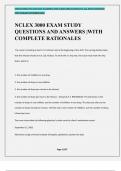Exam (elaborations)
NCLEX 3000 EXAM STUDY QUESTIONS AND ANSWERS |WITH COMPLETE RATIONALES
NCLEX 3000 EXAM STUDY
QUESTIONS AND ANSWERS |WITH
COMPLETE RATIONALES
The nurse is checking a client's I.V. infusion rate at the beginning of her shift. The nursing Kardex states
that the infusion should run at 125 ml/hour. To verify the I.V. drip rate, the nurse must know the drip
factor, whi...
[Show more]
Preview 4 out of 107 pages
Uploaded on
October 7, 2024
Number of pages
107
Written in
2024/2025
Type
Exam (elaborations)
Contains
Questions & answers
Institution
PN 3003
Module
PN 3003
£10.19
Also available in package deal from £35.47
100% satisfaction guarantee
Immediately available after payment
Both online and in PDF
No strings attached
Also available in package deal (2)
PN 3003 Bundled Exams Questions and Answers |100% Pass
1. Exam (elaborations) - Pn 3003 -- maternity and pediatrics exam study guide with complete solutions
2. Exam (elaborations) - Pn3003 variations in health 3 final review study guide
3. Exam (elaborations) - Pn 3003 mat ped exam questions and answers |100% pass
4. Exam (elaborations) - Pn 3003 final exam review study guide with complete solutions
5. Exam (elaborations) - Pn 3003 maternity exam study guide
6. Exam (elaborations) - Pn 3003 -- mental health exam study guide with complete solutions
7. Exam (elaborations) - Nclex 3000 exam study questions and answers |with complete rationales
8. Exam (elaborations) - Nclex 3000-maternal-the neonate practice exam questions and answers |100% pass
9. Exam (elaborations) - Infant nclex 3000 exam practice questions and answers |100% pass
Show more
NCLEX PN-3003 Bundled Exams Questions and Answers |100% Pass
1. Exam (elaborations) - Pn 3003 -- maternity and pediatrics exam study guide with complete solutions
2. Exam (elaborations) - Pn3003 variations in health 3 final review study guide
3. Exam (elaborations) - Pn 3003 mat ped exam questions and answers |100% pass
4. Exam (elaborations) - Pn 3003 final exam review study guide with complete solutions
5. Exam (elaborations) - Pn 3003 maternity exam study guide
6. Exam (elaborations) - Pn 3003 -- mental health exam study guide with complete solutions
7. Exam (elaborations) - Nclex 3000 exam study questions and answers |with complete rationales
8. Exam (elaborations) - Nclex 3000-maternal-the neonate practice exam questions and answers |100% pass
9. Exam (elaborations) - Infant nclex 3000 exam practice questions and answers |100% pass
10. Exam (elaborations) - Nclex 3000 preschooler exam practice questions and answers
Show more
EMILLYCHARLOTTE 2024/2025 ACADEMIC YAER ©2024 EMILLYCHARLOTTE. ALL RIGHTS RESERVED




